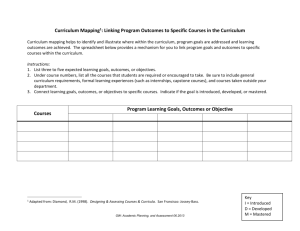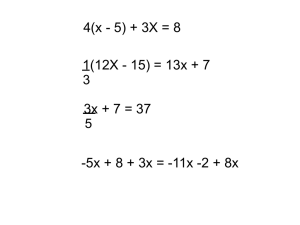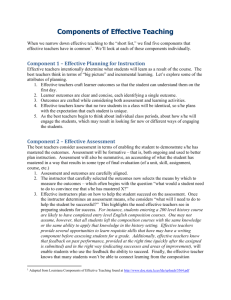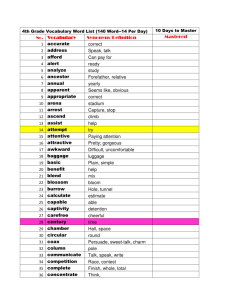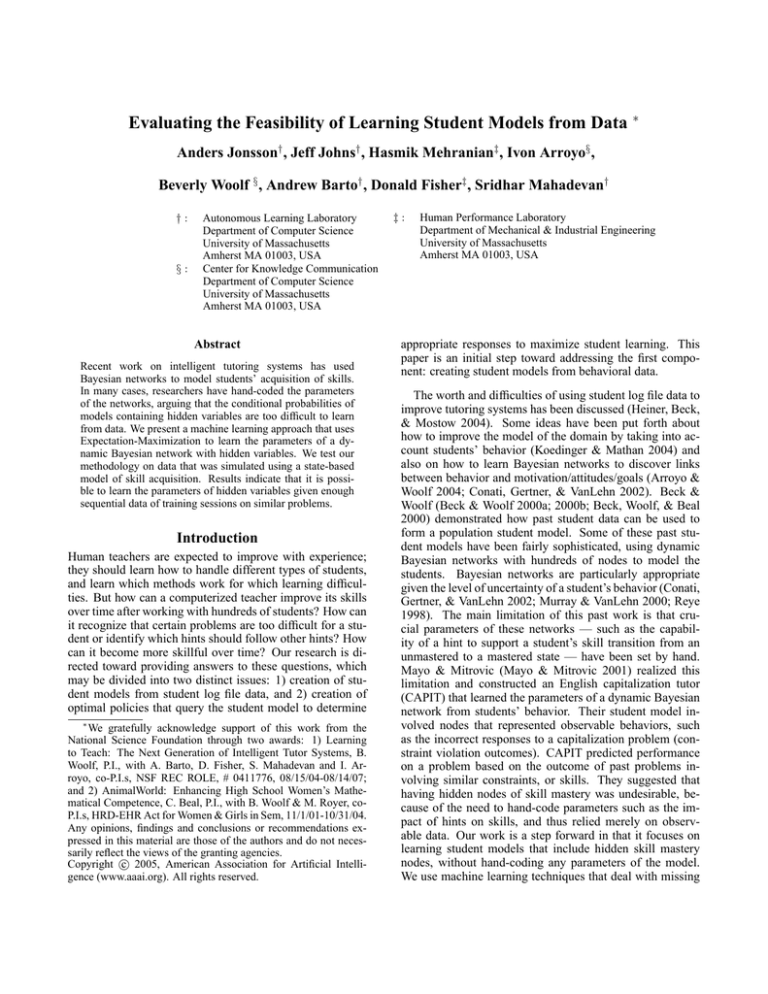
Evaluating the Feasibility of Learning Student Models from Data ∗
Anders Jonsson† , Jeff Johns† , Hasmik Mehranian‡ , Ivon Arroyo§ ,
Beverly Woolf § , Andrew Barto† , Donald Fisher‡ , Sridhar Mahadevan†
†:
§:
Autonomous Learning Laboratory
Department of Computer Science
University of Massachusetts
Amherst MA 01003, USA
Center for Knowledge Communication
Department of Computer Science
University of Massachusetts
Amherst MA 01003, USA
Abstract
Recent work on intelligent tutoring systems has used
Bayesian networks to model students’ acquisition of skills.
In many cases, researchers have hand-coded the parameters
of the networks, arguing that the conditional probabilities of
models containing hidden variables are too difficult to learn
from data. We present a machine learning approach that uses
Expectation-Maximization to learn the parameters of a dynamic Bayesian network with hidden variables. We test our
methodology on data that was simulated using a state-based
model of skill acquisition. Results indicate that it is possible to learn the parameters of hidden variables given enough
sequential data of training sessions on similar problems.
Introduction
Human teachers are expected to improve with experience;
they should learn how to handle different types of students,
and learn which methods work for which learning difficulties. But how can a computerized teacher improve its skills
over time after working with hundreds of students? How can
it recognize that certain problems are too difficult for a student or identify which hints should follow other hints? How
can it become more skillful over time? Our research is directed toward providing answers to these questions, which
may be divided into two distinct issues: 1) creation of student models from student log file data, and 2) creation of
optimal policies that query the student model to determine
∗
We gratefully acknowledge support of this work from the
National Science Foundation through two awards: 1) Learning
to Teach: The Next Generation of Intelligent Tutor Systems, B.
Woolf, P.I., with A. Barto, D. Fisher, S. Mahadevan and I. Arroyo, co-P.I.s, NSF REC ROLE, # 0411776, 08/15/04-08/14/07;
and 2) AnimalWorld: Enhancing High School Women’s Mathematical Competence, C. Beal, P.I., with B. Woolf & M. Royer, coP.I.s, HRD-EHR Act for Women & Girls in Sem, 11/1/01-10/31/04.
Any opinions, findings and conclusions or recommendations expressed in this material are those of the authors and do not necessarily reflect the views of the granting agencies.
c 2005, American Association for Artificial IntelliCopyright gence (www.aaai.org). All rights reserved.
‡:
Human Performance Laboratory
Department of Mechanical & Industrial Engineering
University of Massachusetts
Amherst MA 01003, USA
appropriate responses to maximize student learning. This
paper is an initial step toward addressing the first component: creating student models from behavioral data.
The worth and difficulties of using student log file data to
improve tutoring systems has been discussed (Heiner, Beck,
& Mostow 2004). Some ideas have been put forth about
how to improve the model of the domain by taking into account students’ behavior (Koedinger & Mathan 2004) and
also on how to learn Bayesian networks to discover links
between behavior and motivation/attitudes/goals (Arroyo &
Woolf 2004; Conati, Gertner, & VanLehn 2002). Beck &
Woolf (Beck & Woolf 2000a; 2000b; Beck, Woolf, & Beal
2000) demonstrated how past student data can be used to
form a population student model. Some of these past student models have been fairly sophisticated, using dynamic
Bayesian networks with hundreds of nodes to model the
students. Bayesian networks are particularly appropriate
given the level of uncertainty of a student’s behavior (Conati,
Gertner, & VanLehn 2002; Murray & VanLehn 2000; Reye
1998). The main limitation of this past work is that crucial parameters of these networks — such as the capability of a hint to support a student’s skill transition from an
unmastered to a mastered state — have been set by hand.
Mayo & Mitrovic (Mayo & Mitrovic 2001) realized this
limitation and constructed an English capitalization tutor
(CAPIT) that learned the parameters of a dynamic Bayesian
network from students’ behavior. Their student model involved nodes that represented observable behaviors, such
as the incorrect responses to a capitalization problem (constraint violation outcomes). CAPIT predicted performance
on a problem based on the outcome of past problems involving similar constraints, or skills. They suggested that
having hidden nodes of skill mastery was undesirable, because of the need to hand-code parameters such as the impact of hints on skills, and thus relied merely on observable data. Our work is a step forward in that it focuses on
learning student models that include hidden skill mastery
nodes, without hand-coding any parameters of the model.
We use machine learning techniques that deal with missing
Training Trial 1 for Skill s
Initial
Training
State
Problem
Response
Post−Hint
State
No
Post−Hint
Problem
Response
Initial
Training
State
No
1.0
1.0
S1
1.0
0.4
S1
p 1 = 0.6
1
Post−Hint
Problem
Response
Post−Hint
State
No
1.0
0.4
Problem
Response
No
1.0
S1
Training Trial 2 for Skill s
1
S1
p 1 = 0.6
No
No
0.1
S1
No
0.1
1.0
q 1 = 0.9
S1
0.1
1.0
S1
q 1 = 0.9
Yes
q 1 = 0.9
Yes
Yes
Figure 1: The first and second training sessions for skill s1
data (Expectation-Maximization) to learn parameters of the
network.
Ultimately, our goal is to develop an intelligent tutoring
system that prepares high school students for standardized
geometry tests. To meet this goal, we have developed a computerized tutor called Wayang Outpost (Beal et al. 2003)
that trains students on geometry problems. Successful solution of these problems requires a variety of skills with different levels of difficulty. For instance, simple skills govern
a student’s ability to recognize fundamental geometry concepts (such as the identification of a rectangle), while complex skills are defined as compound concepts (such as finding the side of a 30-60-90 triangle given that the length of
one other side is known). Both simple and complex skills
are used in the process of solving a problem. If we can
identify the set of skills required to solve the test problems,
student modeling consists of estimating a student’s level of
mastery of the set of skills. This model can be used to decide
which problem to present to a student next. We can use the
model to predict whether a student will answer a problem
correctly, and update our estimate based on the student’s actual answer. Learning in the tutor takes place through the use
of hints. A hint describes the information associated with a
single skill and shows the application of the skill to the solution of the problem.
We evaluate the feasibility and accuracy of automatically
learning parameters for Bayesian student models with latent
variables (skill mastery) from behavioral data. To accomplish this goal, we present simulated student behavioral data
generated from a model of the training of one-skill problems, described in Section 2. In Section 3, we introduce
a dynamic Bayesian network to model the problem-solving
activity of students, including hidden (latent) nodes of skill
mastery. We explain and describe the results of using parameter learning techniques that deal with missing data to
learn probability distributions over hidden nodes (the mastery of skills), guesses, slips, and the capability of hints to
make the student master skills, among others. In Section 4,
we compare the learned parameters to the true originating
ones, and end with a discussion of the feasibility of using
machine learning to learn sophisticated student models with
hidden variables from actual student behavioral data.
Generative skill model
Eventually, we want to train a student model on actual student data. However, to test the feasibility of estimating skill
mastery levels, we tested our approach on simulated data
first. We developed a simple training model consisting of
ten trials during which a student is trained on three skills:
s1 , s2 , and s3 . The motivation for this model came from a
state-based approach to skill acquisition (Fisher 1996). We
assume that students do not have skills s1 , s2 or s3 mastered
at the onset of learning. We train only on problems that require one skill. If a student answers a problem incorrectly
during learning, a hint is shown. As a result of seeing the
hint, the student masters the skill with probability
P (si = mastered | si = not mastered, hi = shown) = pi ,
where hi is the hint associated with skill si , i = 1, 2, 3. After the hint is shown, a new problem that requires the same
skill is presented to the student. Let oi be the student’s answer to problem i, which depends on whether the student
Table 1: Conditional probabilities of the skill model.
Problem
1
2
3
pi
0.6
0.5
0.4
qi
0.9
0.8
0.7
successfully applies skill si . The conditional probability of
successfully applying skill si , given that it is mastered, is:
Hint
hit
hit+1
Skill mastery
sit
sit+1
Output
oit
oit+1
Figure 2: The DBN model of a one-skill problem
P (oi = correct | si = mastered) = qi .
In this model, we are not concerned with the precise sequence of training trials but with the number of times each
skill is trained. We generated data for 36 possible combinations of the three skills trained during 10 trials with the
parameter values subjective set according to Table 1.
Figure 1 illustrates the first and second training sessions
for skill s1 . In the figure, S1 denotes the event that s1 is
mastered, and S̄1 denotes the event that s1 is not mastered.
We can calculate marginal probabilities of a student answering correctly after being trained on the skill once or twice.
Following the same logic, we can calculate that probability
for any number of training sessions for each skill.
Student model
There are several things to consider when selecting an appropriate model of student learning. Many factors influence
a student’s behavior during interaction with a tutor, such as
attitude, knowledge, fatigue, and interest. These characteristics are largely unobservable and can only be inferred
from observations. A suitable model should deal with unobservable information and perform inference. There is also
a range of possible observations that can be made about a
student, such as the answer to a specific problem, the time it
took to give an answer, and the student’s facial expression.
A model has to specify which information to include and
which to ignore, both in terms of unobservable characteristics and observations.
The goal of an intelligent tutoring system is to increase
a student’s knowledge of a specific subject matter. As a
student interacts with a tutor, the student’s knowledge level
changes as s/he learns about the subject through the problems and hints presented by the tutor. A student’s attitude
and fatigue level also varies throughout the tutoring session.
A suitable model should describe how a student’s knowledge
and behavior changes over time. Another useful property of
a student model is to predict a student’s behavior based on
current estimates of the student’s characteristics.
We modeled student learning with a dynamic Bayesian
network, or DBN (Dean & Kanazawa 1989), which describes how the values of a set of variables evolve over time.
The variables can be either observed or unobserved, and several fast algorithms can be used to perform inference. In
addition, a DBN facilitates modeling conditional independence between variables, which helps speed up learning and
inference. For these reasons, we believe that the DBN is
exceptionally well-suited to model student learning.
To start simple, we decided to restrict the unobservable
characteristics to a student’s knowledge of the subject matter. We also included observations about a student’s answers
to problems and whether or not a student was presented with
hints. In the simple case we are studying, each problem is
associated with a single skill that the student is supposed to
master. Intuitively, the answer that a student provides to a
problem depends on the student’s current mastery of the associated skill. The student’s mastery of the skill as a result
of working on a problem depends on the previous level of
mastery and whether or not the student saw a hint.
Figure 2 shows two time-slices of the DBN that we designed to model a student’s mastery of a one-skill problem.
At time t, the variable sti is the current estimate of a student’s mastery of skill si , hti indicates whether or not a hint
is being presented, and oti is the student’s answer to the problem. Shaded nodes indicate that the associated variable is
observed. We assume that a student either masters or does
not master the skill, so all variable have discrete values. The
student’s answer to the problem at time t (oti ) depends on
the student’s mastery of the skill at time t (sti ). The student’s
mastery of the skill at time t + 1 (st+1
) depends on the masi
tery at time t (sti ) and whether or not a hint is presented at
time t + 1 (ht+1
).
i
Experimental results
The DBN shown in Figure 2 was used for all experiments.
Each variable in this network is modeled using a binomial
random variable. A latent skill variable sti is either mastered
or not mastered. A hint hti is an observed variable that is
either shown or not shown. Finally, the observation variable
oti is either correct or incorrect.
Multiple experiments were conducted to determine if the
student model parameters could be learned from data. There
are several reasons why learning the parameters is preferable to hardcoding them. If the model accurately describes
the underlying generative process, then learning the parameters results in a model that best fits the data. Furthermore,
each problem in the tutor will have different dynamics depending on the number of skills involved and the inherent
difficulty of the problem. Automating the parameter estimation process captures an individual problem’s dynamics.
Simulated data was generated for three one-skill problems according to the parameter values in Table 1. The
goal of these experiments was to determine the requirements
Table 2: Parameters learned for Problem 1 versus the true generative model. Before learning, the parameters were either
initialized completely randomly or partially randomly with some of the skill transition parameters set close to the true value.
Model Parameters
P (s11 = mastered | h11 = not shown)
P (ot1 = correct | st1 = mastered)
P (ot1 = correct | st1 = not mastered)
P (st+1
= mastered | st1 = mastered, ht+1 = shown)
1
t+1
P (s1 = mastered | st1 = mastered, ht+1 = not shown)
P (st+1
= mastered | st1 = not mastered, ht+1
= shown)
1
1
t+1
P (s1 = mastered | st1 = not mastered, ht+1
= not shown)
1
for parameter estimation in order to recover the true model.
Once the limitations of this method are well understood (i.e.
amount of data required to recover the model), we plan to
use the same technique on actual log data of high school
students using the geometry tutor.
The experiments represent varying levels of problem difficulty, where Problem 3 is harder than Problem 2 which
is harder than Problem 1. The increased difficulty comes
in the form of lower probabilities of a student getting the
problem correct given the skill is mastered as well as lower
probabilities of a hint changing a skill from not mastered to
mastered. For all tests, the probability of getting a problem
correct given the skill is not mastered is zero. This simplification, which will be relaxed in future experiments, means
the student cannot guess the solution without having knowledge of the requisite skill.
Each dataset consisted of 360 instances (ten trials from
each of the 36 possible combinations of skills) of a simulated student answering a problem anywhere from one time
to eight times. If a simulated student is given a problem multiple times, there is more evidence for learning the transition
probability P (st+1
| sti , ht+1
). For each of the three exi
i
periments, the simulated students were assumed to not have
the skill mastered on the first time slice. If the student answered incorrectly, then a hint was shown before the student
attempted to solve the problem again.
The model parameters were learned using ExpectationMaximization, or EM (Dempster, Laird, & Rubin 1977).
This algorithm is used to learn a joint probability distribution when some of the data is hidden. EM alternates between
an E-step and an M-step. In the E-step, the expected values
for the hidden values are calculated based on the observed
data and the current estimate of the model parameters. The
model parameters are then updated in the M-step to maximize the joint likelihood given the statistics learned in the
E-step. Convergence to a locally optimal solution is guaranteed.
To determine the impact of parameter initialization, we
conducted two separate tests. The first test was done using
completely random intialization of the seven free model parameters. The second test randomly initialized four of the
seven parameters. The remaining three parameters not randomly initialized were assigned the following values at the
All
Random
0
.91
0
1.0
.99
.59
.03
Partially
Random
0
.90
0
1.0
1.0
.59
.01
True
0
.9
0
1
1
.6
0
beginning of EM:
P (st+1
= mastered|sti = mastered, ht+1
= shown) = .99
i
i
= not shown) = .99
P (st+1
= mastered|sti = mastered, ht+1
i
i
P (st+1
= mastered|sti = not mastered, ht+1
= not shown) = .01
i
i
The results are shown in Tables 2, 3, and 4. The learned
parameters, which are in the second and third columns of
the tables, are averaged over five trials. The last column in
the tables shows the actual values used to generate the simulated data. For each test, EM is able to recover the model
parameters within an acceptable margin of error. The results
are consistent across Problem 1, Problem 2, and Problem 3;
therefore, problem difficulty does not seem to have an effect
on the quality of parameter estimation.
In particular, the parameters learned using partially random initialization achieve values very close to the true
model. While this is not surprising, it does suggest having
enough sequential data is important to effectively learn the
). To attain this data,
| sti , ht+1
skill transition matrix P (st+1
i
i
students need to be given the same problem (or similar versions of that problem) multiple times. We further examined
this constraint by varying the number of problems the simulated students saw in the training set. Students were given
Problem 3 anywhere from only once up to a maximum of
eight times. EM was able to learn better (i.e. closer to the
true value with less variance) parameters if the simulated
student saw more problems. The results from this experiment are shown in Figure 3 for parameters p3 and q3 . The
resulting values of p3 and q3 were averaged across 20 trials, each involving 360 students. All model parameters were
randomly initialized. The error bars in Figure 3 represent ±
one standard deviation from the mean.
Conclusion
In this paper, we proposed a model of student behavior based
on hidden skills. The skills correspond to geometry concepts
which a student applies to a problem. The model, which
is formulated as a dynamic Bayesian network, is flexible
enough to include additional factors that are known to affect student performance (i.e. student attitude and interest)
in the future. We chose to keep the model simple at this point
to facilitate the evaluation of learning the model parameters
from data.
Table 3: Parameters learned for Problem 2 versus the true generative model.
Model Parameters
P (s12 = mastered | h12 = not shown)
P (ot2 = correct | st2 = mastered)
P (ot2 = correct | st2 = not mastered)
P (st+1
= mastered | st2 = mastered, ht+1 = shown)
2
t+1
P (s2 = mastered | st2 = mastered, ht+1 = not shown)
P (st+1
= mastered | st2 = not mastered, ht+1
= shown)
2
2
t+1
P (s2 = mastered | st2 = not mastered, ht+1
= not shown)
2
All
Random
0
.82
0
1.0
.98
.48
.06
Partially
Random
0
.80
0
1.0
1.0
.49
.03
True
0
.8
0
1
1
.5
0
Table 4: Parameters learned for Problem 3 versus the true generative model.
Model Parameters
P (s13 = mastered | h13 = not shown)
P (ot3 = correct | st3 = mastered)
P (ot3 = correct | st3 = not mastered)
P (st+1
= mastered | st3 = mastered, ht+1 = shown)
3
P (st+1
= mastered | st3 = mastered, ht+1 = not shown)
3
t+1
P (s3 = mastered | st3 = not mastered, ht+1
= shown)
3
t+1
t
P (st+1
=
mastered
|
s
=
not
mastered,
h
= not shown)
3
3
3
Experiments were conducted using simulated data for
one-skill problems. Since the skills are latent variables, we
used the Expectation-Maximization algorithm to learn the
model parameters. Results were presented for three problems with varying degrees of difficulty and different parameter initializations. We conclude from these experiments that
the model parameters can be learned for one-skill problems
provided enough sequential data exists to learn the effect of
a hint. This sequential data condition has an important implication for mining student models from log data. It is only
when students see enough problems of a similar kind that
mining algorithms such as EM can learn parameters that are
important to the student model, such as the capability of a
hint to make a student transition from non-mastery to mastery of a skill. In general, this work shows that mining student models from data seems plausible under certain conditions.
In the future, we will scale up the simulation to include
problems involving multiple skills and allow for students
correctly guessing the answer without having the required
skill. This constraint needs to be relaxed since problems in
the geometry tutor and the SAT exam are multiple choice. In
conjunction with these experiments, we will determine how
well this model explains actual data of high school students
who have used the geometry tutor. Lastly, we plan to use the
learned student models to help choose an appropriate action
for the tutor. We are exploring an optimization framework to
select tutoring strategies based on student model predictions.
All
Random
0
.74
0
1.0
.97
.36
.06
Partially
Random
0
.71
0
1.0
1.0
.38
.03
True
0
.7
0
1
1
.4
0
References
Arroyo, I., and Woolf, B. 2004. Inferring unobservable
learning variables from students’ help seeking behavior.
Analyzing Student-Tutor Interaction Logs to Improve Educational Outcomes: Workshop Proceedings of ITS-2004.
Beal, C.; Arroyo, I.; Royer, J.; and Woolf, B. 2003.
Wayang outpost: An intelligent multimedia tutor for high
stakes math achievement tests. American Educational Research Association annual meeting.
Beck, J., and Woolf, B. 2000a. Reasoning from data rather
than theory. Proceedings of the Thirteenth International
Florida Artificial Intelligence Research Symposium.
Beck, J., and Woolf, B. 2000b. High-level Student Modeling with Machine Learning. Proceedings of the International Conference on Intelligent Tutoring Systems, 5: 584–
593.
Beck, J.; Woolf, B.; and Beal, C. 2000. ADVISOR: A
machine learning architecture for intelligent tutor construction. Proceedings of the National Conference on Artificial
Intelligence, 17: 552–557.
Conati, C.; Gertner, A.; and VanLehn, K. 2002. Using
bayesian networks to manage uncertainty in student modeling. Journal of User Modeling and User-Adapted Interaction, 12(4): 371–417.
Dean, T., and Kanazawa, K. 1989. A model for reasoning
about persistence and causation. International Journal of
Computational Intelligence, 5(3): 142–150.
Dempster, A.; Laird, N.; and Rubin, D. 1977. Maximum likelihood from incomplete data via the em algo-
1
0.9
0.9
0.8
0.8
0.7
0.7
Learned Value for q
3
Learned Value for p3
1
0.6
0.5
0.4
0.6
0.5
0.4
0.3
0.3
0.2
0.2
0.1
0.1
0
True Value
8
5
1
Maximum Sequence Length in Training Data
0
True Value
8
5
1
Maximum Sequence Length in Training Data
Figure 3: Parameter estimation results for p3 and q3 where students in the training set answered anywhere from one to eight
problems. The learned parameters are closer to the true model with less variance when more sequential data is provided.
rithm. Journal of Royal Statistical Society Series B, 39:
1–38.
Fisher, D. 1996. State models of skill acquisition: Optimizing the training of older adults. Aging and skilled performance: Advances in theory and applications: 17–44.
Heiner, C.; Beck, J.; and Mostow, J. 2004. Lessons on using its data to answer educational research questions. Analyzing Student-Tutor Interaction Logs to Improve Educational Outcomes: Workshop Proceedings of ITS-2004.
Koedinger, K., and Mathan, S. 2004. Distinguishing qualitatively different kinds of learning using log files and learning curves. Analyzing Student-Tutor Interaction Logs to
Improve Educational Outcomes: Workshop Proceedings of
ITS-2004.
Mayo, M., and Mitrovic, A. 2001. Optimising its behaviour
with bayesian networks and decision theory. International
Journal of Artificial Intelligence in Education, 12: 124–
153.
Murray, R., and VanLehn, K. 2000. DT Tutor: A decisiontheoretic, dynamic approach for optimal selection of tutorial actions. Proceedings of the International Conference
on Intelligent Tutoring Systems, 5: 153–162.
Reye, J. 1998. Two-phase updating of student models
based on dynamic belief networks. Proceedings of the International Conference on Intelligent Tutoring Systems, 4:
274–283.

